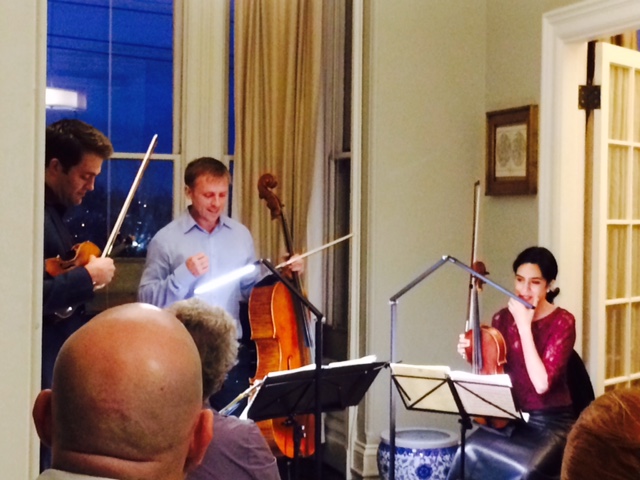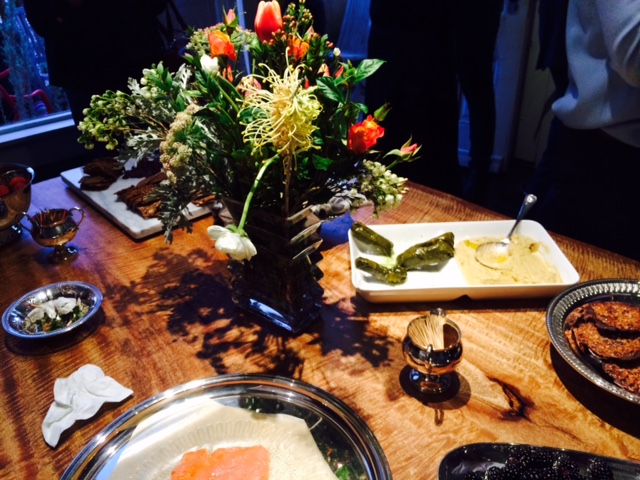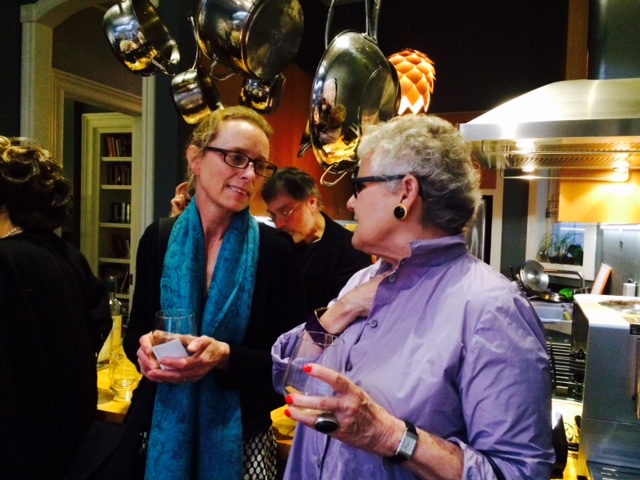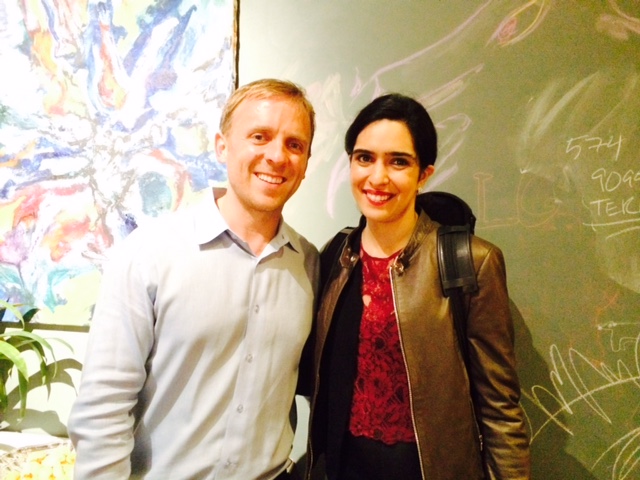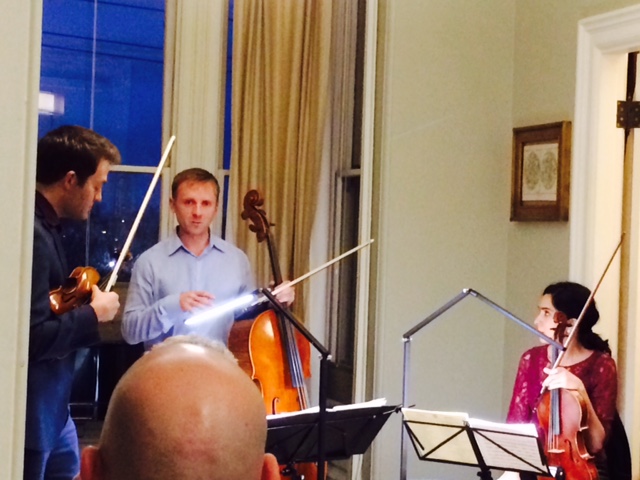My latest concert experience was hosted by cellist and founder of Concerts by the Square, Robert Howard. With a nod to 19th-century European salon music, Concerts by the Square offers evenings of intimate chamber music complimented by enticing hors d’oeuvres and wine. These events provide the perfect setting for audience members and musicians to share their passion for musical exploration.
In 2015, Concerts by the Square traveled to Kenya to perform and teach at Mt. Kenya Academy in Nyeri. It was fascinating to learn about this project and exciting to see the photos of children smiling and playing their instruments.
This concert was held at a gorgeous Victorian house built in 1890 and located one block from Alamo Square Park (Alamo Square Park, famous for its colorful Victorian houses, is one of the most photographed neighborhoods in San Francisco). The elegant, welcoming atmosphere was perfect for an intimate salon-music experience.
Preceding the performance, I enjoyed a glass of wine and delicious hors d’oeuvres in the dining room while chatting with other guests. This home complements 19th century art, architecture and furnishings with sophisticated modernity. It is open and luminous, an invitation to musical discovery.
This night’s theme, Vienna to Potsdam, was a program of string trios performed by violinist Owen Dalby, violist Meena Bhasin, and Robert Howard himself on cello. Owen Dalby, second violinist with the St. Lawrence String Quartet, is also artist-in-residence at Stanford University. Meena Bhasin has been artist-in-residence in numerous locations worldwide in partner with Carnegie Hall. Owen and Meena are co-founders of Decoda, New York City’s trailblazing society of virtuoso chamber musicians, arts advocates, and educators. Robert Howard is also an educator and performs “everywhere from Costa Rican swamps, to the Paris metro, to Venetian gondolas.”
The program featured works by Gideon Klein and Ernst Von Dohnányi.
Before playing, Robert gave a short explanation about the first string trio by Czech pianist and composer Gideon Klein. Klein composed this piece when he was 26 years old and completed it nine days before he was sent to Auschwitz. String Trio was his last composition.
Klein was forced to discontinue his studies in March of 1939 when the Nazis closed all institutions of higher learning following their occupation of Czechoslovakia. In 1940, he was offered a scholarship at the Royal Academy of Music in London. Unfortunately, anti-Jewish legislation prevented his emigration. During this period, all compositions and performances by Jewish musicians were banned. Klein’s own work could not be performed, however he began to perform widely as a concert pianist.
The first movement, Allegro, is frenzied and mischievous, interrupted with sudden bursts of melody thick with vibrato. I imagined someone busy running around the kitchen, simply running around with lots of energy and excitement. Perhaps Klein’s head was filled with thoughts of adventure and moving to London.
Lento, the second movement, changes the mood dramatically. This movement, composed of variations on a Moravian theme, is mournful and reflective, with brief moments of light glistening through the darkness. Was Klein affronted with the impossibility of moving to London? Predicting the course of his imminent future?
Brought to life again, Molto Vivace, the third movement, is like a kid who is about to do something that she knows she shouldn’t do. Throwing off the forlorn mood of the previous movement, the maniacal melody is thrown about and augmented between all three instruments.
This piece was a total of about fourteen minutes, however, the richness of the musical journey made me feel as if I had watched a three-hour opera. From my seat, I had a clear view of Meena Bhasin. It was fascinating to watch her animate each note, playing simply beautifully.
The next piece was the Serenade for String Trio, composed by Ernst von Dohnányi, a Hungarian pre-Bartok composer, pianist, and conductor.
The first movement, Marcia; Allegro, opens with a proud and noble mood. Following is a sudden change of melody, dark and insidious, led by the cello and joined in alternately with violin and viola. Like a battle between a knight and a dragon, the knight prevails as the mood shifts back to the original melody, ending the movement victoriously.
Following is Romanz; Adagio Non Troppo, a movement that opens, dream-like, with dewy pizzicato and a soft violin solo; I imagined the state of someone stupidly in love. Following is an interjected change of melody, righteous and valiant, led by cello and violin. Here, I saw another character playing suitor, trying to impress and win over. Then, quieting, the melody returns to pizzicato and violin, finishing soundlessly.
The third movement, Scherzo; Vivace, opens mischievously with violin playing pizzicato, joined slyly by the velvety sound of the viola, then the robust voice of the cello, augmenting the energy to a sudden explosion, then disintegrating back to a sneaky atmosphere. The villainous mood is broken by a softly singing melody, and the two contrasting melodies battle to take presence. Here, I imagined an evil witch thwarted by the hero.
Following is the Tema con Variasiono: Andante con moto. Opening with a complete contrast to the Scherzo, the slow, romantic melody is woven together by all three instruments. Suddenly, lanced by the cello’s solitary pizzicato, the melody changes to an aggravated, stormy mood. Returning briefly to the opening melody, the tranquility is broken again by a flurry of aggravated tremolo. After this outburst of energy, the movement ends, once again peaceful.
The Finale is a race of cello, viola, and violin bouncing off of and echoing one another, fragmented by chords joined in by all and pedal notes held by the cello. The mood is disrupted with a return to the dragon’s melody of the first movement. Slowly disintegrating, the dragon disappears like the reminisces of a bad dream, and the movement ends with an explosive chord.
I have been to many chamber music concerts, and this evening’s performance made me wonder how musicians learn to create and tell stories through their instruments.
It is mysterious to me how the musicians were able to transpose this range of emotions so accurately into the music. Each note was cherished and respectful to life. I felt that they were transmitting these sentiments not only as musicians, but as intellectuals with the respect and desire to tell the stories of these composers. This performance was an affirmation of the richness that Concerts by the Square brings to the community.
To learn more about performances hosted by Concerts by the Square, visit their website: http://concertsbythesquare.org/#






